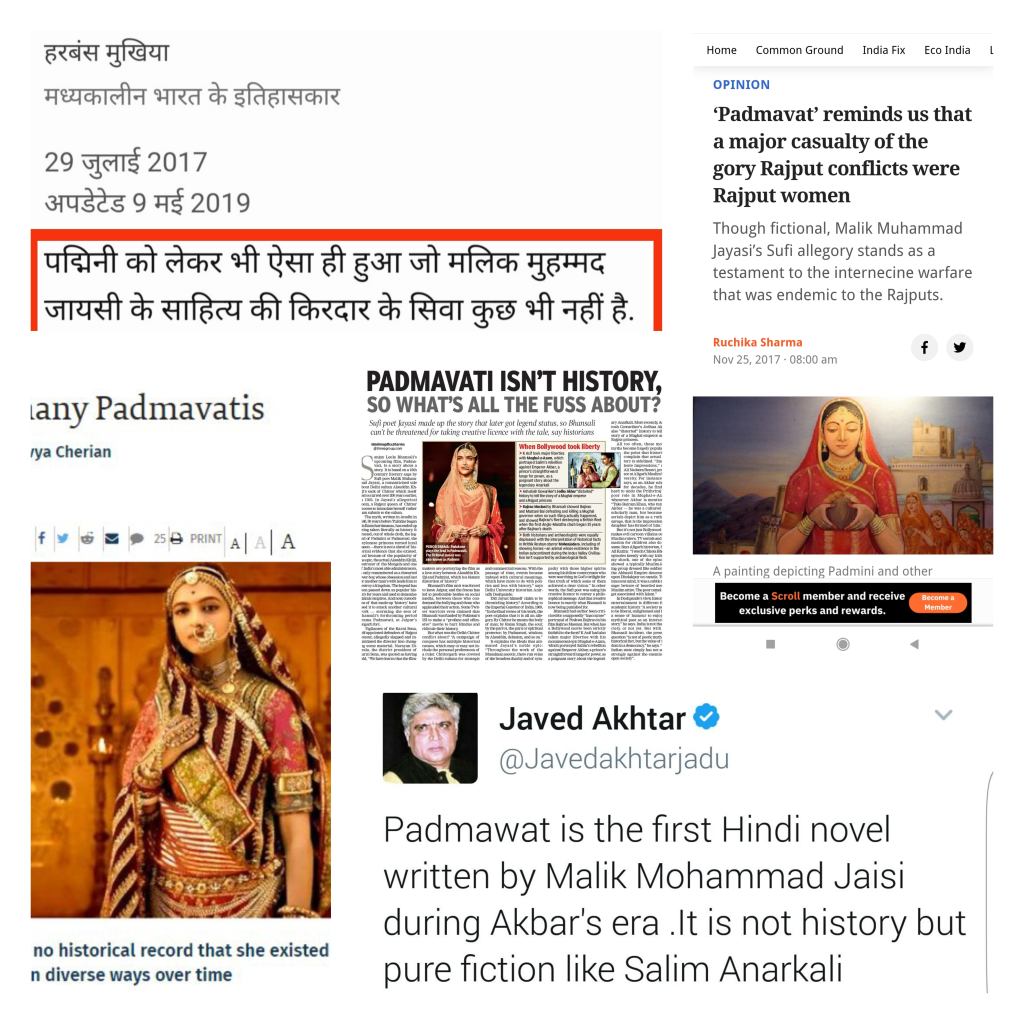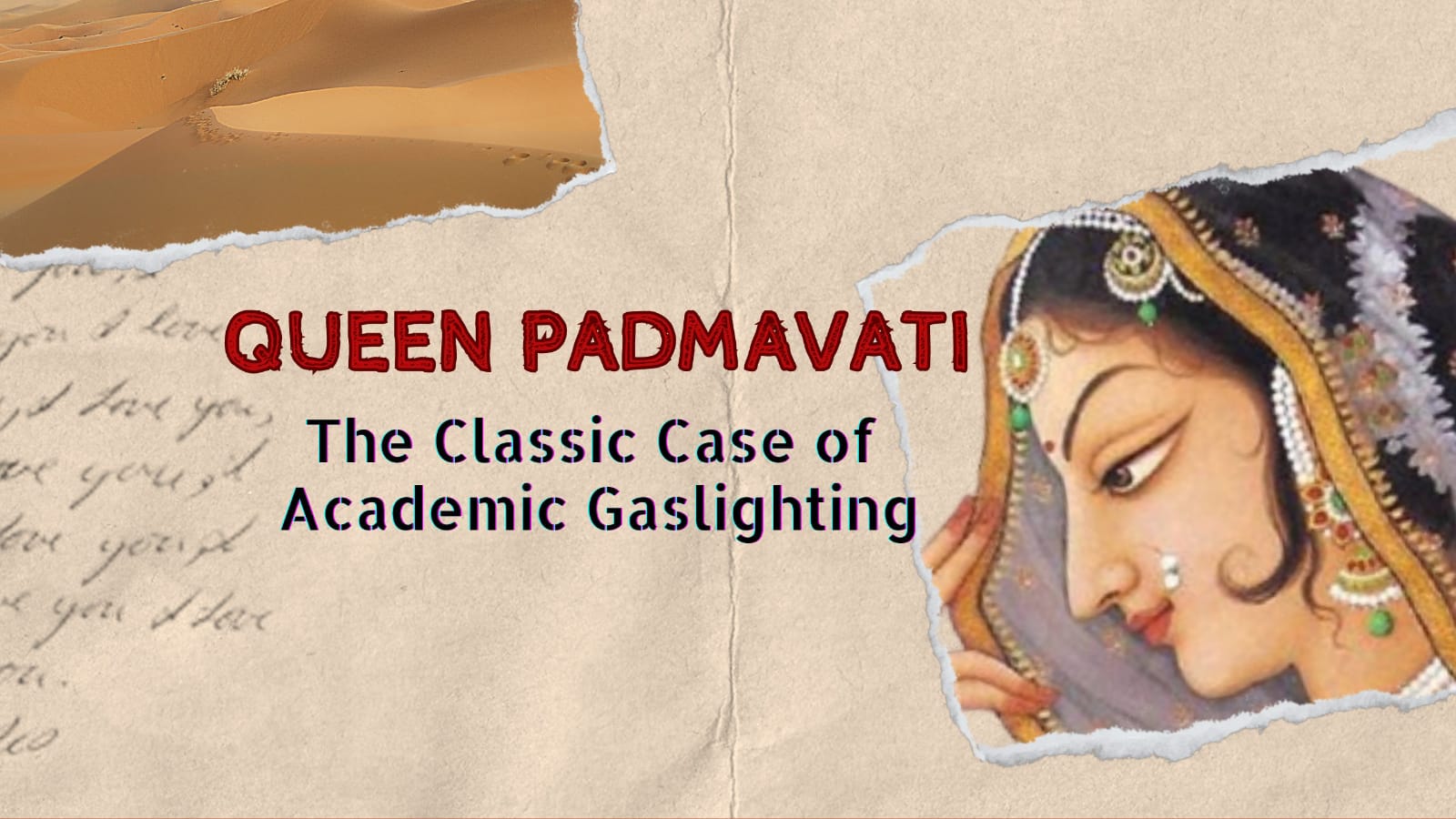Queen Padmavati: The Classic Case of Academic Gaslighting
Activist Edward Snowden once quoted, “The whole system revolves around the idea that the majority can be made to believe anything, so long as it is repeated loudly and often.”
We often encounter historians wailing about non-historians writing history nowadays but I wonder why doesn’t anyone complain about partisan historians or those bestselling ‘historical fictions’, which arm-twist history with their imaginary conjectures ?

A recent ‘historical fiction’ on ‘Raskapoor’ is grabbing eyeballs and critics & historians are showering praises on it, citing it as authentic account of a courtesan, wronged by royalty. But in the same breath, the same armchair critics will go on proclaiming that the character of Rajput Queen Padmavati (Padmini) was ‘fictional’ and there was hardly any substance in that ‘fable’. Isn’t this unsettling how a self-respecting character like Padmavati is denounced as a ‘myth’ while another character like Raskapoor from Rajput history is acknowledged as ‘authentic’ as it suits the moth-eaten stereotype of ‘spoils of royalty’. Historical fiction remains one of the most ludicrous genres of literature because it gives one the liberty to fictionalize history and historicize fiction while remaining free of the responsibility of being questioned on the touchstone of credibility!
The Construction of Binaries between Myth & History
Scholar Dalpat Singh Rajpurohit elaborates the roots of the elitist bias within dominant discourse in his book ‘Sundar Ke Swapn’. Rajpurohit quotes that the collection of oral traditions of Colonel James Tod and the work of George Grierson gave Ramchandra Shukla a strong basis for the periodization of Hindi literature and divided it into two periods (branches) of Bhaktikaal and Ritikaal; later Bhakti was attributed to the folk and Ritikaal was associated with the feudal system. After having been linked to the feudal system, literature of the Ritikal was considered of ‘low status’. Ramvilas Sharma even called Riti Kavya as feudal or court poetry, thereby denying the respectable recognition to Riti-poetry.
To elaborate this tendency further, we see how the Royal accounts of the Rajput Rulers of the Ritikal, orally preserved and then written by native Bhats, Charans, Harbolas are downplayed & cancelled by the some modernists by repeatedly calling them a ‘myth’, ‘exaggeration’ & ‘sponsored writing’ and even ‘royal self-fashioning’.
18th century onwards, insistence on witnesses, empirical proofs and documentation in history gained such primacy that history and myth were considered as antithetical to each other. The fact that all human civilizations of the world have been involved in myth in their cultural forms and manifestations from the very beginning is almost pushed to the margins and it is ignored that myth is not completely meaningless and untrue.6
The insistence on modernity (reason, proof and lived experience), rose in disciplines like art, literature, history, sociology’; that lead to ‘myth’ being dubbed as ‘lies’ and ‘imagination’. On basis of this, selective historical incidences and characters started getting cancelled, being assumed as ‘myth’.
Burden of Proof and Padmavati
The Padmini of Jaysi and the Padmini of Rajasthani sources are different narratives with objective difference. Based on the cross examination of the two we can’t decide on historicity of either Further the Rajasthani version actually predates that of Jaysi’s, not only by language and style, but also data points. For example, Jaysi mentions that Ratansen attacked Kumbhalgarh’s ruler Devpala. But earliest source of Rajasthani version – Kavimalla Hetamdan doesn’t mention any Kumbhalgarh, likely because none existed at the time of its creation (Kumbhalgarh was founded by Rana Kumbha in the 15th century, while Rawal Ratansen and Padmini existed in the 12th century).
A queen called Padmavati that existed, whose remnants lie scattered all over Chittaur, whose descendants are still present to testify her genealogy, is cancelled repeatedly by terming her as a ‘myth’ or ‘fictional’; just because Amir Khusro doesn’t mention her in one of his chronicles! Moreover, modernist historians rely primarily on contemporary chronicles of Alauddin Khilji’s reign like Khazain-ul-Futuh and Duval Rānī va Khizr Khān(Amir Khusro); Tarikh–i Firoz Shahi (Zia ud Din Barani) and Futuh–us-Salatin (Abdul Malik Isami )9 to probe the presence of Padmini, who remains elusive in all these works. Hence, a conclusion on ahistoricity of Padmavati is drawn on basis of ‘absence of her literary mention’.
Historian Rajesh Kochhar cites a plausible explanation that Alauddin Khalji’s chronicler Amir Khusro records the jauhar committed by the queens and other women in the Ranthambore Fort which was conquered in 1301. It was the first description of the custom in Persian. Two years later, the Chittor fort was reduced under similar circumstances but no jauhar is mentioned. It will be wrong to conclude from this that no jauhar took place. It could be interpolated that Muslim chroniclers may not have been overly enthusiastic about recording the goings-on in the Rajput camp. It is probable that Amir Khusro’s interest was in reporting a new phenomenon to his readers. Once the purpose had been served, there was no need to report the incident again.5
Remarkably, scholars are also of the opinion that there is an oblique reference to ‘Padmini’ in Khazain–Ul–Futuh (The Treasures of Victory) written by Amir Khusro, when he symbolically illustrates ‘hud-hud’, a mythical bird in Islam and allegorically suggests the Sultan’s obsession with Padmini.7

Moreover, Prof. Madhav Hada also asserts in his research10 that Abul Faz’l categorically mentions ‘the beautiful wife of Raja Ratansi, who was desired by Alauddin Khilji’.8 Munhata Nainsi, a 17th century chronicler of the Rajputana region wrote ‘MUNHATA NAINSIRI KHYAT’ that also mentions Padmini and Jauhar. The late 17th century work termed ‘Rawal Ranaji Ri Baat’ also mentions ‘Padmini as wife of King Ratan Sen for whom Alauddin laid seige to the fort’.
Acharya Ramchandra Shukla’s seminal work on Malik Mohammad Jaysi’s ‘Padmavat’ lauds the exactitude of historical and geographical description between Chittaur and Kaling and difference between Sinhal and Lanka. Mention of characters like Orissa king of Gajpati ancestry who helped Ratansen proves that Jaysi’s work was not based on concoctions and fares well on touchstone of legitimacy. If the locations, characters and events of Jaysi’s work are so accurate, why would he wedge in a sole fictional character called Padmini in his work?
Prof. Purshottam Agarwal also mentions in his book ‘Padmavat : An Epic Love Story’ that another luminous Katha-Kavya ‘Chhitai Charit’ which was written before Jaysi’s ‘Padmavat’, has direct reference of the ‘Padmini of Chittaur’.
The numerous local bards and poetry compositions like Gora Badal Kavitt, Hemratan’s Gora-Badal-Padmini Chaupai, Padminisamiyo, Jatmal Nahar’s Gora Badal Katha, Dayaldas’s Ranaraso, Dalpati Vijay’s Khummanraso, Chittaur-Udaipur Patnama reverberate with the mentions of Queen Padmini, which are unfortunately cancelled academically because Jaysi’s creation of ‘Padmavat’ pre-dated this entire alternate body of work. It is undeniable that Padmavat by Jaysi is a stupendous body of work but it is also true that Jaysi’s work being used as the sole Vantage Point in assessing historicity of Padmavati/ Padmini is unjustifiable.
Absence of mention is not proof of absence
Historian William Dalrymple says that in actual fact, none of the Mughal descriptions of the Peacock Throne mention the Kohinoor, because the Mughals preferred red stones of light, like spinels and rubies, and those are what the Mughal chroniclers describe. Not one of them mentions the Kohinoor.1 But then; can a casual conclusion be drawn on this basis that Kohinoor was never in India or rather, never in the Mughal possesion? Can we simplistically assume that anything that is ‘not mentioned’ in contemporary chronicles was ‘non-existent’?
As per the statement of the renowned historian Mubarak Ali, the word ‘Din-I-Ilahi’ was not used during the period of Mughal emperor Akbar. Historians reject that Akbar created a ‘new faith’ by pointing out that Akbar created a Sufi fellowship, which served as a imperial discipleship programme.2 Prof. M. Athar Ali mentions in his work ‘Mughal India: Studies in Polity, Ideas, Society and Culture’ that the theory of Dīn-i Ilāhī being a new religion was a ‘misconception’ which arose because of erroneous translations of Abu’l-Fazl‘s work by later British historians. So, does this lead us to believe that the very notion of a secular sect called ‘Din-i-Ilaahi’ being conceived by Akbar was nothing but a ‘figment of imagination’ of the Orientalist historians, who misconstrued it & yet circulated it?
More so, while the historicity of Padmavati is repeatedly cancelled by repeatedly terming her as ‘fictional character’, at the same time, a fictional character called Jodha as Rajput wife of Akbar is popularly peddled as ‘history’. As a matter of fact, there is no reference to Akbar’s wife by the name Jodha Bai, be it in Akbar’s biography Akbarnama or Jahangir’s autobiography Tuzk-e-Jahangiri. It is noteworthy that Mughal chronicles do not record Hindu names of Rajput wives; they know them only by their Muslim titles. Akbar’s wife’s name was kept out of the records as was the custom of (purdah) at that time. During the reign of Akbar, it was ordained that the names of Mughal wives were not to be mentioned in public. Important women were given titles that were to be used instead of their names.3
So, where did the name Jodha bai come from? Interestingly, Goa-based author Luis de Assis Correia claimed to the extent that Jodha Bai, believed to be the Rajput princess who allegedly married Mughal emperor Akbar, was actually a Portuguese woman named Dona Maria Mascarenhas4. So going by the references, can one deduce that since no Mughal chronicles mention a Hindu Rajput wife of Akbar called Jodha, the Rajput wife never existed at all? But do the historians care to correct this popular notion with their authority, the way Padmavati is painted as ‘mythical’? No, because then it would deflate the ballyhoo of liberal ethos of the Mughal Court and bring Mughal patriarchal values of those times to the surface.
Nuance is All
Historians, academicians, writers or filmmakers can have their ideological or political leanings but its unnerving how history is handpicked by few as per their tastes and suitability! It is engrossing how few characters from history are cherrypicked to be mounted as authentic to propel a specific narrative in public discourse while some other character is cancelled or diminished in size to fuel another politico-academic agenda. Such is the case of academic denialism that Padmavati has been subjected to, which has played a key role in the project of moral and historical diminution & socio-political decimation of the Rajput History, that needs reviewal and renewal.
*Padmini and Padmavati are used for the same person in different sources alternatively.
© Aeshvarya Thakur , First Published here
References:
- https://indianexpress.com/article/india/historian-william-dalrymple-theres-a-tendency-in-indian-history-to-have-everyone-as-either-a-demon-or-an-angel-8369230/
- Ali, Mubarak. “Akbar in Pakistani Textbooks.” Social Scientist, vol. 20, no. 9/10, 1992, pp. 73–76. JSTOR, https://doi.org/10.2307/3517719. Accessed 14 Apr. 2023.
- Waseem, Durre. “THE PORTRAYAL OF MUGHAL WOMEN IN THE EARLY MUGHAL ART AND ANALYZING THE REASONS FOR SCARCITY OF THEIR IMAGES .”
- Correia, L. d. A. (2017). Portuguese India and Mughal Relations, 1510-1735. India: Broadway Publishing House.
- http://www.tribuneindia.com/news/comment/rajputs-their-women–muslim-rulers/524111.html
- Walter J. Harrelson, “myth and history”, The Encyclopedia of Religion
- Awan, Muhammad Tariq. History of India and Pakistan. Pakistan, Ferozsons, 1991.
- The Ain I Akbari by Abul Fazal Allami translated by H. Blochmann, H. S. Jarrett, low price publications, 2011.
- Saiyad Athar Abbas Rizvi, Khalji Kaleen Bharat (History of Khaljis) – 1290-1320
- Madhav Hada, ‘Padmini : Itihas aur Katha-Kavya ki Jugalbandi’

